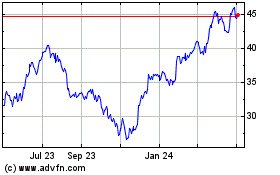By John D. Stoll
The United Auto Workers spent the 1980s primarily worried about
job security. As Japanese car companies stole Detroit's market
share and robots invaded auto plants, union bosses anticipated less
for their army of workers to do.
They convinced General Motors Co. and its rivals to form what
was called a Jobs Bank that kept paying employees even if their
positions were eliminated by automation or market shifts.
When GM filed for bankruptcy protection two decades later, the
Jobs Bank was held up as an example of the gaggle of gold-plated
benefits the UAW amassed in contract negotiation upon contract
negotiation. Needing a government bailout in 2009 to get the
General back on its feet, union officials gave up many of those
perks. Executives vowed to never give them back.
If this autumn's long UAW strike teaches us anything, it's that
GM has a long memory. Its new generation of leaders doesn't want to
return to the old days. The company is pouring billions into
electric cars and autonomous vehicles, and needs maximum
flexibility to minimize the risk.
Fighting the UAW has proven tough. The union is more concerned
with shoring up its dwindling ranks than doing GM a favor.
Automobile design is headed for big changes, and a preference for
shipping production out of the country threatens its ranks.
Electric vehicles, which are less complex than gasoline
counterparts, are expected to require 30% fewer workers -- bad news
for a union that now only represents about 150,000 people at Big
Three auto plants -- a minority of American auto workers. The
industry's most profitable vehicles, meanwhile, are increasingly
coming from Mexico.
This new GM doesn't want to take financial responsibility for
the changes electric cars will bring. Want proof? A negotiation
that should have taken at most a couple of weeks of talks to
resolve blew up into a 40-day strike, costing GM about $3 billion
in lost production and costing UAW members $8,700 per worker in
lost compensation. This would be a lot for Chief Executive Mary
Barra to lose over a routine contract negotiation.
Had the bargaining just been about pay raises, monthly
health-care costs or bonuses, a deal would have been struck with
far less bloodshed, people involved in the talks say. The new
contract costs GM $350 million in additional annual labor costs, or
52% more than the roughly $230 million increase executives have
been targeting. These numbers are rounding errors for a company
earning $150 billion annually, and it doesn't take a protracted
strike to get on the same page. ( Ford Motor Co. agreed to terms
with the UAW after a week of formal talks).
But because the UAW came into GM negotiations looking to win
back certain items it gave up during the financial crisis, the auto
giant dug in, these people say. The union wanted an increase in
defined-benefit payments for the large portion of employees still
eligible for pensions; it wanted additional payments to retirees;
and it wanted more say in where GM builds its products.
"What GM was saying is, 'We can afford the new economics of a
labor deal, but we cannot afford to go bankrupt again,'" said Colin
Lightbody, a longtime contract bargainer for Chrysler who is now a
consultant. "That became the underlying agenda in these
negotiations and sent a message in these negotiations that 'we're
sticking to our guns on that.'"
Art Schwartz, a former GM labor negotiator and president of the
consulting firm Labor and Economics Associates, told me this week
the auto maker succeeded in "retaining the right to run the
company." He pointed to Paragraph Eight in the hulking GM-UAW
contract, which says the union's job is to negotiate -- everything
else is up to the company.
This is an important message not only to the union, but also to
Washington. Bloomberg recently reported the White House wants to
control where cars are made. This is a recipe for disaster in a
capital-intensive and cyclical business where flexibility is
king.
"We have maintained our ability to adjust our workforce in
response to changing industry levels," GM's Chief Financial Officer
Dhivya Suryadevarea said in a call with analysts this week.
GM isn't alone in needing wiggle room. Fiat Chrysler Automobiles
NV is planning to merge with French auto maker PSA Group, the maker
of Peugeot. This will increase Chrysler's exposure to the European
market, which is saddled with excess production capacity and known
for giving an upper hand to labor unions in protecting unprofitable
jobs. Strong American assembly plants are core to case Chrysler has
made to PSA for the merger.
Anyone questioning whether GM and its rivals still need this
flexibility should study a spreadsheet that details what's called
the factory-utilization rate. Long an indicator of a company's
underlying health, it measures the percentage of a plant's capacity
to churn out cars used during a 16-hour workday. Auto executives
hate it when the lights are off on a plant. Every minute of those
16 hours that the assembly line isn't running represents piles of
wasted cash.
GM, flush with U.S. factories even after its bankruptcy, is
responsible for about one-third of the American auto industry's
unused production capacity, according to the Center for Automotive
Research. That's a disproportionate burden for a company with just
17% market share.
That's why the company announced a plan last year to close
several factories, including a facility in Lordstown, Ohio, and
stuck to that plan even as President Trump, several lawmakers and
union leaders criticized the move. The data indicate more pain on
the horizon.
GM builds the electric Chevy Bolt and small cars, for instance,
at a factory in Orion Township, Mich., that it was forced to keep
open indefinitely under the terms of its bailout from the Treasury
Department. The sprawling facility north of Detroit employs about
750 people and is capable of building tens of thousands of cars a
month. It currently builds 170 a day, or less than 10% of what it
is capable of building during a two-shift workday, according to
Wards Intelligence.
The industry average for capacity utilization? Roughly 88%,
Wards says.
GM is keeping Orion open because it sees the factory as a test
bed for electric vehicles, which currently are money losers because
of the high cost of batteries. Another EV is slated to be added to
that assembly line during the next contract.
The company is also committing to keep open another factory near
Detroit it had previously planned to close. The good news for
workers at that plant is that the new product will be a pickup
truck, competing in the hottest segment in America. The risky part:
The truck will be electric.
But these cars and trucks represent more of a half-court shot
than a slam dunk, and GM has shown willingness in recent years to
cut losses when projects go from dream to headache.
The latest contract insures GM can quit banging its head against
the wall anytime it wants.
Write to John D. Stoll at john.stoll@wsj.com
(END) Dow Jones Newswires
November 01, 2019 13:10 ET (17:10 GMT)
Copyright (c) 2019 Dow Jones & Company, Inc.
General Motors (NYSE:GM)
Historical Stock Chart
From Mar 2024 to Apr 2024

General Motors (NYSE:GM)
Historical Stock Chart
From Apr 2023 to Apr 2024
